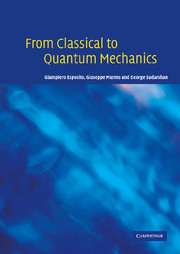Book contents
- Frontmatter
- Contents
- Preface
- Acknowledgments
- Part I From classical to wave mechanics
- 1 Experimental foundations of quantum theory
- 2 Classical dynamics
- 3 Wave equations
- 4 Wave mechanics
- 5 Applications of wave mechanics
- 6 Introduction to spin
- 7 Perturbation theory
- 8 Scattering theory
- Part II Weyl quantization and algebraic methods
- Part III Selected topics
- References
- Index
4 - Wave mechanics
Published online by Cambridge University Press: 14 January 2010
- Frontmatter
- Contents
- Preface
- Acknowledgments
- Part I From classical to wave mechanics
- 1 Experimental foundations of quantum theory
- 2 Classical dynamics
- 3 Wave equations
- 4 Wave mechanics
- 5 Applications of wave mechanics
- 6 Introduction to spin
- 7 Perturbation theory
- 8 Scattering theory
- Part II Weyl quantization and algebraic methods
- Part III Selected topics
- References
- Index
Summary
This chapter begins by exploiting the Einstein–de Broglie relation and the notion of symbol, as defined in Eq. (3.6.6). The following steps are the local and global conservation laws associated to the Schrödinger equation, the probabilistic interpretation of the wave function, the spreading of wave packets and transformation properties of wave functions.
The solution of the Schrödinger equation for a given initial condition is then studied. For this purpose, one first expands the initial condition in terms of eigenfunctions of the Hamiltonian operator. This is then ‘propagated’ to determine the evolution of the wave function. Thus, one is led to consider the Green kernel of the Schrödinger equation, and the boundary conditions on the wave function that lead to complete knowledge of stationary states. A dynamics involving an isometric non-unitary operator is also studied. The chapter ends with an elementary introduction to harmonic oscillators and to the JWKB method in wave mechanics, plus examples on the Bohr–Sommerfeld quantization.
From classical to wave mechanics
The correspondence between differential operators and polynomials in k relies on the notion of the symbol defined in Eq. (3.6.6). Now we are aiming to pass from a function on phase space, i.e. the classical Hamiltonian, to an operator which, by analogy, is called the Hamiltonian operator. Such a transition is non-trivial because the map from symbols to operators contains some ambiguity. Such a transition is always possible if polynomials in p have constant coefficients. When this is not the case, i.e. if the coefficients are functions on the configuration space, there is an obvious ambiguity in the association of an operator with xp or px, for instance.
Information
- Type
- Chapter
- Information
- From Classical to Quantum MechanicsAn Introduction to the Formalism, Foundations and Applications, pp. 115 - 175Publisher: Cambridge University PressPrint publication year: 2004
